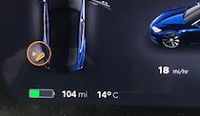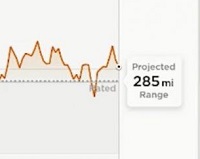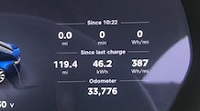Tesla Range FAQ
Last updated 21-Mar-2024
The available range in a Tesla is the forecast on how far the car can go before it runs out of electricity and is a frequently asked question by many owners who get confused or frustrated by it. It's rarely a consideration with a petrol/gas car as the available miles can be easily and quickly replaced at a fuel station. Whilst most people accept the manufacturers miles per gallon figures are far from the truth, with electric cars it seems to be examined to a much higher level of scrutiny, probably because people are generally more concerned about EV range. In an electric car the available range is of course more important as you need to plan charging, if and when you need to stop to charge.
Variability in energy consumption
The distance any car can travel on a full "tank", whether Petrol, Diesel or Electric, will differ depending on how it is driven, where it is driven, what it is carrying and the weather. Consequently, an EV with a quoted range of say 300 miles does not mean that it will travel 300 miles on a full charge.
The range in a petrol car and some other makes of EV, when they show a figure which is increasingly common, it is based on recent driving style and the number is a reasonable prediction assuming the driving situation has not changed as the recent past. With EVs this is sometimes referred to as a "GOM" or GuessOMeter, in part because EVs are more sensitive to changes in driving situations due to their higher efficiency, in other words the variability in factors such as weather and speed are masked to some extent in petrol/gas cars by their general inefficiency.
Tesla do things differently as rather than show a figure based on recent driving history, they show it based on the rated range which at best, in summer, can be nearly correct, and at worst, in winter, a large over estimate. However, once you understand what the numbers represent, and what it doesn't, you can then decide whether you want to show miles or km, or prefer not to know and show %.
Before we look at the figures displayed it is of course worth recognising that it is impossible to know exactly how far a car will travel on a given amount of electricity in the future. The best you can do is come up with an educated guess for the range in miles or km. There are a number of reasons for this:
- Warm weather, downhill, steady 50mph or 80km/h driving and efficiency will mean efficiency is good and less stored electricity is required to cover a given distance.
- Cold weather, rain, uphill, high-speed driving and the consumption will be higher and consequently range lower.
- In even moderately cold weather the first part of the journey can use much more energy than the later part of the journey meaning one long journey is more efficient that several shorter journeys even when the total distance travelled is the same. This is because the battery and car will need to use energy to warm up.
- You could mitigate some of that heating by preheating or preconditioning the car before departing. The energy use in the car is still higher but replenished from the charge point.
- Not all energy consumption is captured by the car, the car needs to be awake, so charging while locked and even preheating may not be recorded in the car.
- Some use the recent past energy consumption as a guide for future energy consumption, but the circumstances may not be the same, the car may have been warm when the past average was taken and the cold when you start driving etc which will result in an incorrect prediction.
- Unlike a petrol car, the variability in consumption can be very significant, driving a cold car in winter can result in 2 or 3 times the energy consumption as the same car when warm in winter. A petrol car, the consumption figures rarely vary for environmental factors and vary more for how hard the car is being driven.
While other electric car manufacturers take the recent history to determine what might be the future in their GOM (guess o-meter), the figure Tesla display is worked out differently and is in effect a proxy for the available kwh in the battery.
Tesla take the EPA rating (the official energy consumption figures per mile from regulatory testing) and assume that a mile requires that much energy. The battery management system works out how many kwh of energy are available and converts that to miles or km using that official efficiency figure. So, is this meaningful? The way we like to think of it is to compare it to say a lift. A lift might say "max 8 people" whereas the technical limit is not the number of people, it is a maximum weight. We intuitively accept that 7 very large people may be the actual limit and 9 or 10 children would be fine, but by using a number of people it is using something that we can more readily comprehend. Saying a car has 63.2kwh of available energy is accurate but not useful, converting that to 193 miles is more useful even though its technically less accurate.
Figures displayed in the car
In different countries and at different times, the official tests have been different which has resulted in different figures for the same car. The common tests have been EPA, NEDC and WLTP and these have also varied from giving figures which are close to the real world or very inaccurate. The problem is not unique to EVs. Even petrol cars have this problem as miles per gallon vary in different countries because a US gallon is a different size to a UK gallon.
Depending on the age and model of the car one of the following will be used:
-
Rated Range

US cars and cars in the rest of the world since about 2019 have displayed the Rated range based on the EPA testing standards in the US. The figure will vary by model as the efficiency varies, the Performance MX on 22" wheels being the worst with a Model 3 on 18" Aero wheels being the best.
One source of confusion is on earlier cars, in some countries, they used the NEDC figures which were very optimistic in comparison to the EPA figures. These cars usually had the option to show "Typical" which is described below, but two identical cars could be showing different figures depending on which was selected. It is also difficult to compare a care with the NEDC rating to a car with the later WLTP rating to see which is better as a lower WLTP figure could still result in a better real world range.
A second source of confusion is that Tesla now use the EPA figure in all cars, however in some countries the published figures are based on the WLTP testing cycle which is slightly different. A common question is "why does my car not show the rated range when full" and this is often caused by the differences in testing figures used.
-
Typical Range

When the NEDC figures were being used for the Rated range, this was so inaccurate Tesla added a "Typical" range option. This is virtually identical to the Rated range in concept, except the figure is based on a figure Tesla felt was appropriate. "Typical" is fairly close to the official EPA figures and so this option was not available on cars with the EPA rated range.
To change between Typical and Rated, you select which you prefer in menu, although increasingly cars now only show the rated range.
-
Ideal Range

This was used in some of the very early cars and was based on Ideal conditions, thought to be around 50mph. The idea was to exaggerate the available range for marketing purposes, and this was only done in the US market. As battery sizes have increased the need to know the maximum you could eek out of a car has become less important. It is totally unrealistic and no longer used in cars made today.
In summary, each of the methods above just use a different figure to translate the available kwh into miles or km at the fixed ratio. If we revisit the lift comparison, it is essentially assuming different sized person as the typical person to calculate how many people can get in the lift, i.e. in the US it may be 85kg as average, in Europe 80kg.
When considering these figures, just like when getting into a lift, you need to make some mental adjustments to the figures for the current conditions. If you were getting in a lift with some pretty big people, or at say an airport where people have suitcases, you'd mentally adjust the capacity to a smaller number, and similarly if you were about to drive at high speed in an EV you would know the range would fall. Familiarity with your car and how it reacts to different conditions will help you make more meaningful adjustments.
Other sources of range information
As said, the above figures are all based on a fixed approximation of how much energy is required to drive 1 mile. Tesla do have other energy screens that can provide different figures:
Projected Range

The only place you can see a range based on recent driving behaviour is to display the energy screen and look for the projected range figure. This uses the average energy consumption over the length of the recent distance selected and uses this and the BMS reported available kwh to work out a range. There is also an option to show this on instantaneous consumption but this is of little benefit. This figure can fall rapidly in winter in cold weather due to the early parts of any journey being quite high on consumption, something thing that typically improves on a journey.
Trip estimate

Using the same energy screens, if a trip is entered into the navigation, then the car will calculate the consumption for the journey and track actual to estimated consumption and predict an arrival state of charge. It will also suggest charging or reducing speed if required. This is probably the most useful method if on a single long journey.
Economy

In addition to the range figures, the car can show the economy of the car, this is typically the economy on the last journey, spanning short stops and the economy since last charged. It's worth knowing what your car used for Typical consumption as a mental reference against which you can compare, for instance a Model S is around 300 wh/m unless it's a performance which is nearer 330 wh/m. You can then mentally gauge whether you're exceeding this considerably or not.
Real world and working range
All car manufacturers publish range based on official testing approaches and as suggested above, they all end up with a slightly different figure. But all these range calculations are from FULL to EMPTY. In practice, two things come into play when thinking of the real-world working range.
Tesla advises that other than the LFP battery packs found on the SR+ models built in China, the car should not be charged over 90%. For everyday real-world range, we think it's worth accepting this point to not over stress the battery while it leaves a bit more for the odd day when you need it. The second aspect is planning to end the day on empty is also risky. Few people would ever run a car to absolute empty before filling with petrol, and the same is true for batteries. There are a couple of good reasons for this, firstly it gives a safety margin in the case of a last-minute diversion or sudden change in conditions, and secondly the battery does not like being run too low. We therefore think a 10% to 90% working range of the battery is a sensible rule.
We also know the performance of the car is worse in winter and range can fall by 20% in cold conditions, rain etc. If the car is used for multiple short journeys, then the performance can fall further, but as a rule of thumb we work on 80% of the rated range being realistic in winter.
Taking these two factors into account, the working everyday range of an EV should be calculated at 80% of 80% of the rated range. A car with a 300-mile rated range is therefore capable of doing about 190 miles in winter without any real concern over recharging during the day or pushing the limits of the battery. If you routinely plan to do more than that in a day, then you will need to plan on charging in winter.
Degradation
Batteries do lose some capacity over time and Tesla now warrant new cars to retain 70% of their capacity at the end of 8 years or the miles limit (which varies by model). Those displaying % will simply not see any reduction in the available miles at a given state of charge. Those showing miles may see a reduction over time.
There a few simply checks before you become too worried about degradation:
- If in Europe and other regions, the car will not be displaying range based on the same testing standard but the slightly more pessimistic US figure. As a result, the car may appear to only have about 95% of the range compared to the published figure. This is not a problem.
- If you have a Model 3 or Model Y and apply the Always Be Charging mantra, then the car may have drifted out of calibration and require a few simple steps to help it improve accuracy. Our guide to BMS calibration provides the steps you need to take.
- We have created a guide to degradation and calculating your battery capacity.
Frequently asked questions
Should I show percent or miles/km?
One of the most hotly debated topics is whether you should show a range at all on the dash or just show a percentage. The basic arguments for each follow:
- Showing mileage is a direct proxy for available battery energy available and while some mental adjustment is needed to cater for inefficiencies due to weather, speed etc, the figure is expressed in units of how far you travel. Showing percentage tells you very little because even the battery capacity can change and 40% of something is still unknown. We also don't drive %'s we drive miles. Those that show % typically don't comprehend what the miles figure represents and find a different way such as the satnav to predict consumption.
- Showing % avoids the inaccuracy of showing miles. The miles figure is almost always inaccurate and so potentially misleading, overstating the distance the car can actually travel. Showing percentage removes the anxiety of looking at the range in miles and wondering whether they are achievable or not.
We display range, we let the battery icon give us an indication of the fraction of how full, but there is no right or wrong here and owners should try both to see which they prefer.
Why does my car not show the manufacturers quoted range when full?
One of the common reasons is outside of the US, the quoted range in the literature is based on the WLTP testing cycle whereas the car shows the range based on the EPA testing cycle.
If you have any wheels other than the standard, including removing the covers, and you update the wheels in the car, the range will alter to a lower figure.
The BMS can drift slightly and is pessimistic in nature, it will therefore under report available capacity. We have a guide on how to help the BMS recalibrate.
In cold weather, the battery simply can't make available the full capacity, again resulting in an under reporting.
The battery can experience some degradation, and some loss is inevitable. There is usually a small amount lost fairly quickly in the carís life, and then it plateaus to a slow degradation over time.
What is Vampire drain?
One aspect of Tesla ownership that surprises some people is the car uses electricity even when not being driven. This is called Vampire drain. This can range from a few miles per day to quite significant amounts of energy that could deplete the battery within a week. We have created a guide to vampire drain and how to minimise but the key points are:

To reduce vampire the following steps are recommended
- Only use Sentry Mode needed. This uses huge amounts of electricity for what it does and will deplete the battery in a few days if you are not careful
- Uncheck the 'Always connected' option found a little oddly under the Display tab.
- Turn off 3rd party applications that poll the car like teslafi, as this is preventing the car from entering deep sleep. This would have a similar effect to leaving always connected turned on
- For the most aggressive form of energy saving, also turn on Energy Saving. The downside to this is the car can take longer to wake up when you get to the car, but if you were leaving the car for a few weeks, this is a good option
- Lastly, do not open the Tesla app to check on the car. This causes the car to wake up again using energy.
A combination of the above will minimise the vampire drain in the car and reduce the amount of battery loss over night or whenever you leave the car.
How can I get more range in winter?
We have created a guide to driving a Tesla in winter.